The mission seems to be going well enough; it’s been tough, but you’ve persevered, making your way through some tense situations by avoiding the gaze of patrolling guards. You’ve just infiltrated the enemy base — now it’s time to assassinate someone. You’re hiding, maybe in the bushes or around a corner, and wham, some guard spots you. Alarms sound, the world begins to move in slow motion, and an alert pops up on screen.
“You’ve been caught. Time to start over.”
This story has been retimed following the release of FPS Boost for Dishonored: Definitive Edition on the Xbox Series X and S.
If you’ve ever played a stealth game, chances are high that this is your experience. If you’re lucky, the game will blare an alert and you’ll have to hide somewhere in the area, only to emerge to try again once the guards are feeling better about themselves.
How would you define the stealth genre? I think most people would agree on a definition like “a stealth game is one where players must reach an objective while remaining unseen and unheard.” Some players will tell you that a non-lethal route is an absolute must, while others pride themselves in killing absolutely everyone on the map, yet they manage to remain undetected. Stealth enthusiasts will proudly tell you of the ways they ‘ghost’ through levels, leaving no trace of their presence.
“Don’t be seen, don’t be heard.” Until recently, that was the genre’s mantra, and few games made any attempt at thinking outside the sneaky cardboard box. Hitman tried it with its disguise mechanic, but beyond that, all stealth games more or less play the way they have since Castle Wolfenstein, back in 1981.
Then along came Dishonored, and with it, Lady Boyle’s Last Party.
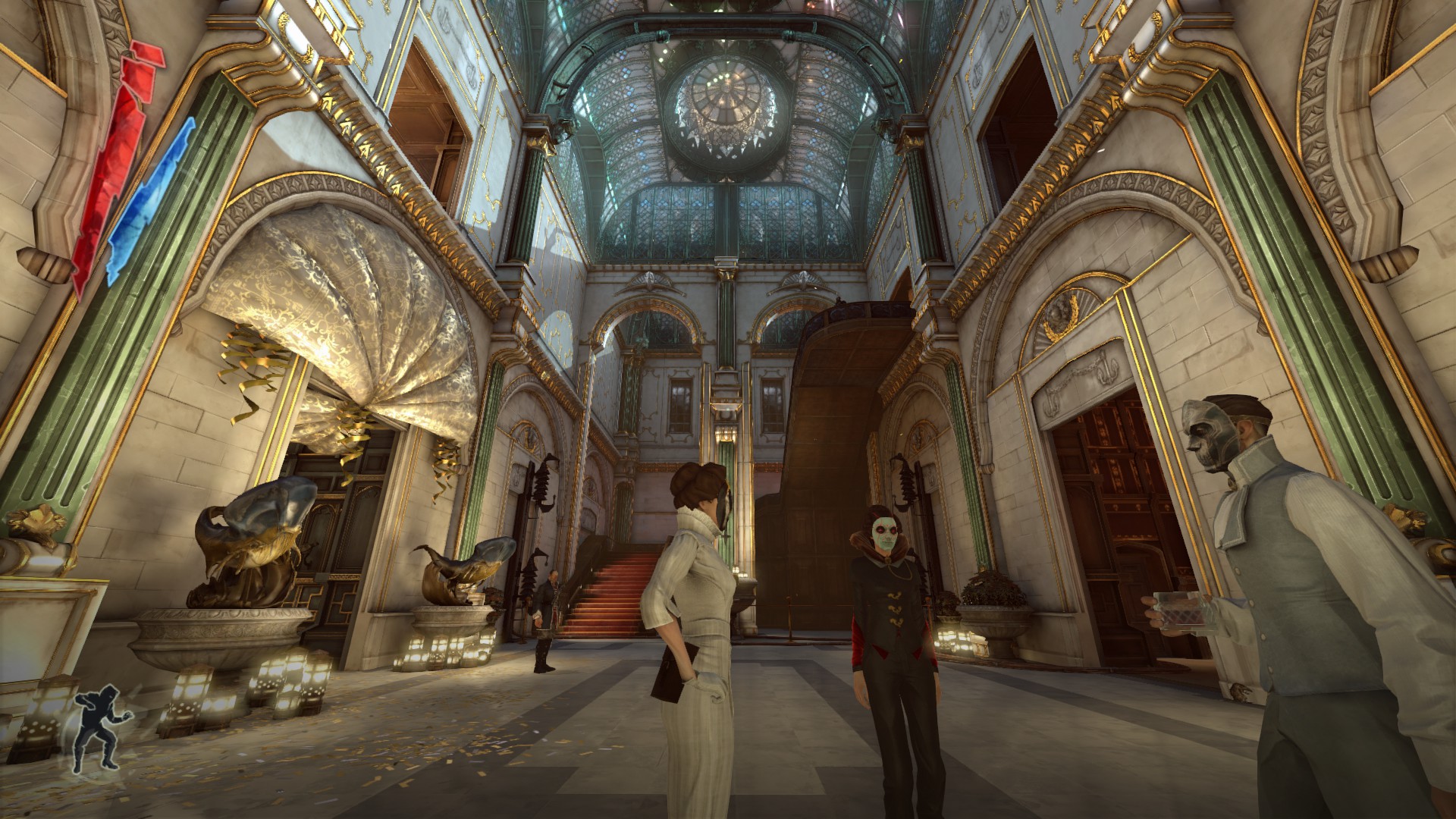
If you’ve not played Dishonored, here’s the elevator pitch version: It’s Thief meets Half-Life 2. You play a former bodyguard framed for the murder of the Empress. You have been given a variety of supernatural abilities by a mysterious character known as The Outsider. Your goal is to eliminate those who framed you while uncovering the plot behind the Empress’ murder. Also, you wear a trademark mask — this gets important later.
The mission starts simply enough: Samuel the boatman escorts you to the party, then outlines what you’re supposed to accomplish, (in this case, getting rid of one Lady Boyle), and parks the boat, setting you free to tackle the mission. Originally, I wrote “tells you what to do,” but this is Dishonored — instead of telling you what to do, like just about every stealth game out there, Dishonored assigns you a target and lets you determine the best way to do things.
Once you’ve climbed out of the canals, your attention is quickly drawn to the Boyle mansion. If you’ve ever played Half-Life 2‘s developer commentary mode, you’re probably aware of how Valve uses linear pathways to ensure a player’s always looking in the right direction. When you exit the doors of the train station, you’re going to be facing the Citadel — not only that, but all the lines in the scene, from alleyways to power lines to building silhouettes, point to the Citadel. Everything draws your attention, and Half-Life 2 will repeat this sequence multiple times throughout the game, highlighting the building’s importance.
Dishonored does something completely different.
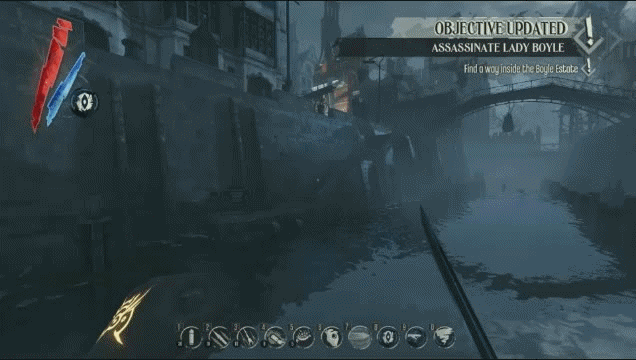
The stairs that most players will climb to get from the canals to the level’s “ground floor” don’t lead you directly to the mansion. Instead, the mansion’s bright lights and vibrant colours — which stand in direct contrast to the dreariness of the rest of the level — are sure to catch your attention. If they don’t, well, the crack and thump of the fireworks will.
It’s an interesting divergence from more traditional stealth games, which tend to feature quiet levels with the occasional guard noises. In most games, there’s an aspect of listening — the game’s soundscape fades into the background so the player can listen for the telltale footfalls of an approaching guard. Dishonored transgresses against tradition, its mansion screaming “hey, look at me! Come here and check me out!”
There can be no question as to which mansion is Lady Boyle’s.
Now that you know where to go, it’s up to you to figure out how to enter. The walls surrounding the mansion are too high to climb or teleport over, and you’re ultimately left with two basic choices: sneak in through the right side of the mansion or walk straight through the front door on the left.
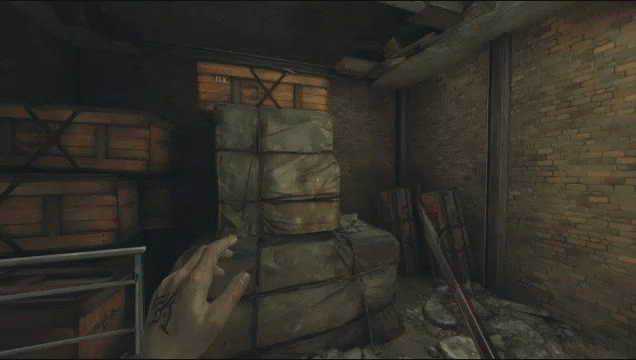
First, let’s talk about the more traditional route on the right hand side. It’s fairly straightforward — keep out of sight, stay low, open a window here, jump across buildings there, find a key, open a door, climb some crates and chains and jump down into the gardens… which happen to have a couple guards and a nobleman hanging around. The guards, for what it’s worth, don’t particularly seem to care that you’re around. If anything, they’re actually nice.
No, it’s not a glitch, you’ve just infiltrated a costume party.
It’s no surprise to guards that a guy wearing a mask is walking around, because, well, everyone’s wearing a mask. Unless you engage in any suspicious behaviour, like shooting people, they don’t particularly care what you do. One of the game’s side missions involves the delivery of a letter. The man you’re supposed to deliver it to happens to be the aforementioned nobleman. When you hand him the letter, he reads it, revealing that it is a challenge to a duel.
Congratulations, you’re about to engage in a perfectly legal gunfight!
Assuming you win, you’ve just murdered a man in plain sight of the guards, and they don’t care! It’s against everything a modern stealth game stands for. Not only have you killed someone, but you’ve done it with an audience, and they were none the wiser as to your true purpose. In that moment, everything about the genre changes. The form of the game has transformed, but the function, the idea that you must remain undetected, remains the same.
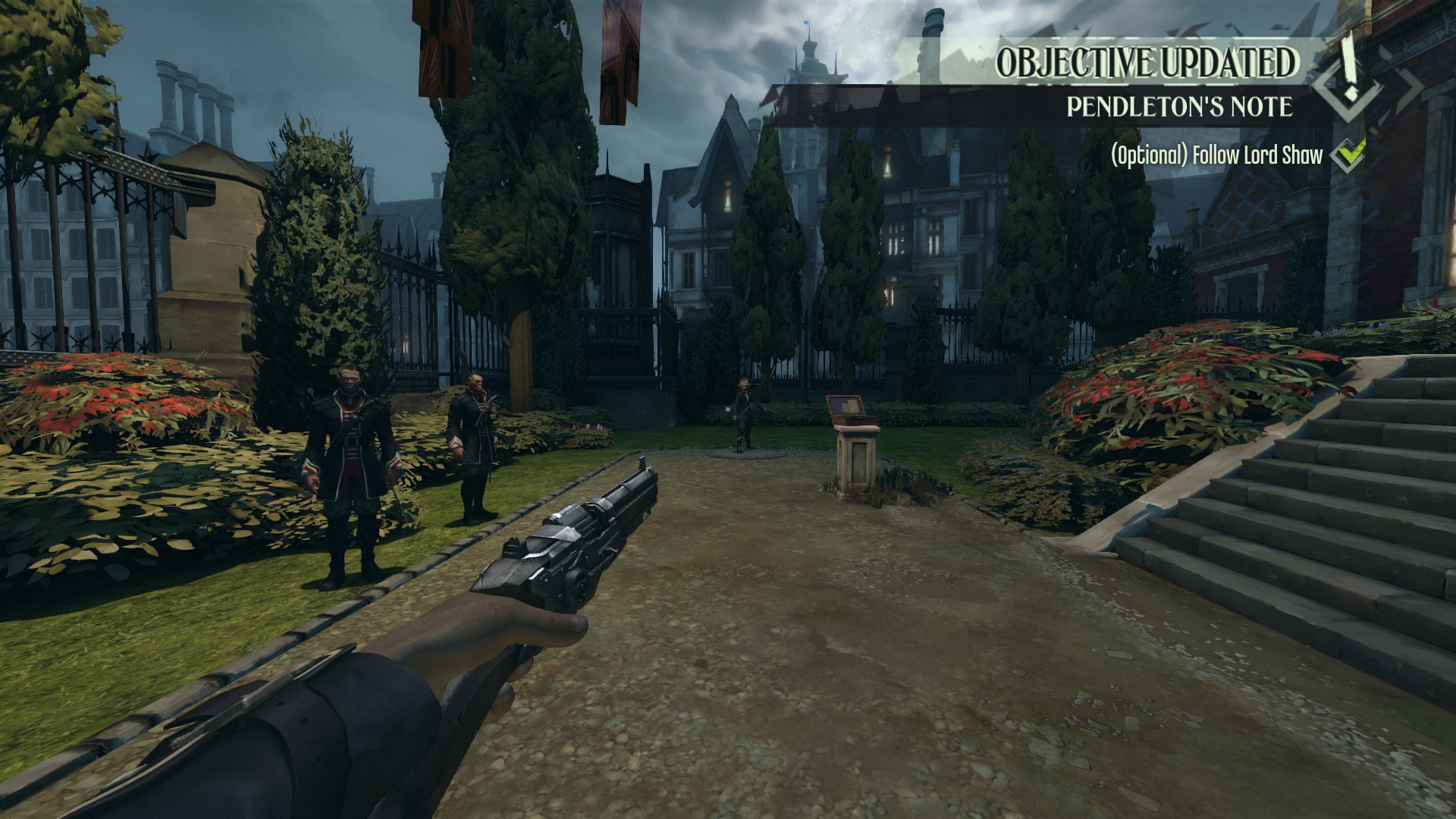
Let’s go back. Now you’re going in the left side. Hop over the fence, and you’ll find yourself faced with a bunch of nobles. Just like before, the nobles aren’t interested in attacking you — they’re too busy discussing the party and the wait to get in. A breeze catches an invitation, giving you an opportunity to snag it for yourself. Presenting it to the guard gets you into the party. Head to the mansion, walk in the front door and…
You’re in.
Let’s be clear, there are a host of ways to enter the mansion. Find the right balcony, and you can enter through a bedroom. Back door? Sure, why not. Front door? Absolutely. The Boyle mansion has plenty of entrances, and it’s up to you to approach it how you want.
What makes the front entrance great, however, is how Dishonored asks you to do the least-stealthy thing you can possibly do, perhaps even less stealthy than shooting a man in the face in a duel. This maverick stealth game doesn’t merely give you the opportunity to waltz in the front door, it also asks you to sign the guest book. Seriously, you can approach the guest book and sign it with your character’s name, Corvo Attano. All the guests think you’ve got a deliciously dark taste — that you’re some nobleman who’s decided to wear the mask of the nation’s most wanted man.
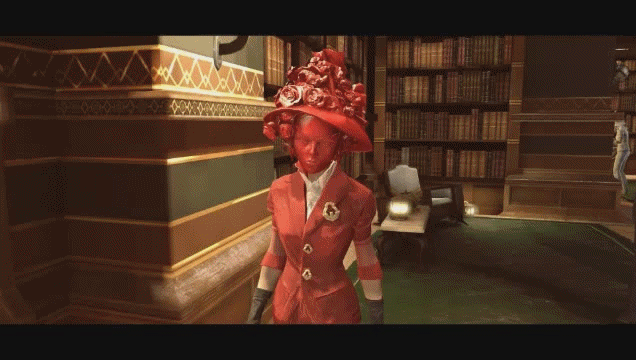
Now you’ve got to find the right Boyle, of which there are three, each virtually identical save for the colour of their costumes. You can, of course, engage in traditional stealth behaviour by sneaking upstairs, avoiding anyone’s line of sight, and pilfering through the bedrooms until you find some clue that tells you which one to kill.
Or you could talk to the party guests.
Once again, Dishonored completely ignores the traditions of the genre and does its own thing. Disguise has been done before — just check out the Hitman series — but actually conversing with the party guests? To the best of my knowledge, this is a first. Guests comment on your mask, ask you to get them drinks, and heavily hint that you should go upstairs. If the level has one weakness, it’s the constant insistence you should go upstairs. Unfortunately, when playtesting the game, Arkane discovered that players refused to go upstairs simply because guards — the bad guys — told them they couldn’t. As a result the game pretty much screams “go upstairs!”
Some stealth games have gone the “find the right target” route before, but I can’t think of any that have required some detective work to suss out the target. It’s yet another clever and fun twist in a level that’s already one of the most inventive of the past decade. When you find the right Boyle sister, all you have to do is eliminate her.
Maybe you decide to shoot her, or perhaps you summon an army of rats to attack. If you want, you can simply wait until no one’s looking, stab her, and be on your way. Talking her into heading up to her room works as well. There are plenty of options, but perhaps the most notable one is the non-lethal choice.
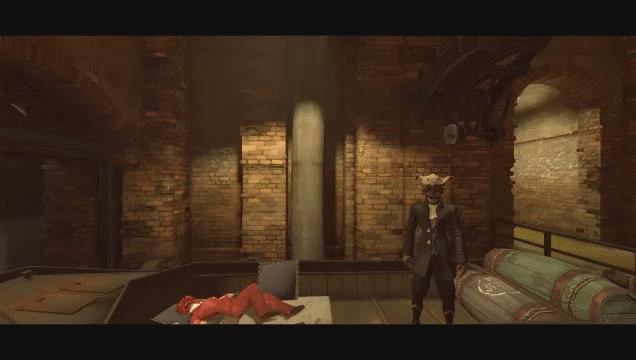
The average modern stealth game treats non-lethal play like the best way to play, not just because of the skill it requires, but for moral reasons, which is totally understandable, given that killing is generally the worst action one human being can commit. Unfortunately, this has a tendency to be rather limiting, as it incentivizes one kind of play over all others, which is completely at odds with what stealth games are all about.
Dishonored, in yet another clever twist, makes the non-lethal route seems to be the worst one. You can kidnap Lady Boyle and deliver her to a man in a boat, who will take her… somewhere. Dishonored has non-lethal options for other targets as well, and while all of them effectively ruin the lives of the very bad people you’ve set out to stop, Lady Boyle’s fate is heavily implied to be the worst one by far. Non-lethal stealth in Dishonored is, at least in this case, the more dishonorable option.
Again, this is just one of many choices available to you. Prior to Dishonored‘s launch, the creators spoke about a playtester who stuck a mine on a rat, possessed a rat, and guided it into a room of guards, where it exploded, killing them. One of my favourite tactics is starting a fight, getting shot at, freezing time, possessing someone, and walking them in front of the bullets. Lady Boyle can be shot, stabbed, dumped in a river and drowned, eaten by rats, thrown against a wall with such force she dies… it’s all about playing how you want. If you want to be nonlethal, be nonlethal, but you don’t have to, and there’s no special incentive, like extra XP, that makes it the “right” choice. It’s merely one of many, and that’s what makes Dishonored so cool.
It’s because of Dishonored that I think enthusiasts and designers have got the genre wrong. At their insistence, nearly every stealth game I’ve seen recently champions nonlethal, undetected stealth.
Personally, I think stealth games are a unique kind of puzzle game. Your average puzzle game, like Portal 2, has one problem and one solution. Solve the puzzle, move on to the next puzzle, repeat. A stealth game instead presents you with a goal, like “kill this guy,” or “steal that thing,” or “get to that place.” Then it gives you a handful of tools, and then an obstacle of some kind — a problem to solve — and says “ok, so how do you want to do this?” It’s the same basic formula, but rather than a single solution, the game invites you to solve the puzzle in the way you see fit.
The stealth genre is a playground, a stage for player creativity.
Dishonored works because it rejects the notion of there being a “right” way to play a stealth game.
Earlier, I mentioned the idea of ghosting through levels — playing without any detection whatsoever. Ghost runs in games were another way to get creative mileage out of a genre built for that very purpose. The creators hadn’t built their games for ghosting, but the tools were there. Creative players used ghosting as a means to demonstrate their skill.
Unfortunately, non-lethal or ghost playthroughs have largely become the way to play stealth games. Assassin’s Creed forces a restart if you’re caught. Deus Ex: Human Revolution grants far more XP to non-lethal players than others. Sneaky Bastards, a magazine for stealth enthusiasts, claims that there is no stealth genre, merely action games with stealth, because nothing lives up to their ideal of what stealth should be (Justin Keverne’s great counterpoint in the comments of the linked article is well worth a read). The genre is in danger of becoming homogenous, because people increasingly treat it as if there is only one ‘true’ way to play. An entire genre can’t sustain shooters with just one kind of gun or action games with just one kind of attack, likewise, stealth can’t sustain just nonlethal or ghost runs.
Dishonored works so well because it rejects the notion of there being a “right” way to play a stealth game. It’s a game about tools, a game about choices. It celebrates you. Dishonored treats stealth as a matter of motive rather than physical awareness. Because the essence of video games is interactivity, it stands to reason that the best games are the ones that give the player the most options, and Dishonored is all about those options. Keep your true purpose hidden, eliminate the target assigned to you, and leave, but feel free to sign the guestbook and leave your mark, saying “I was here.”
GB Burford is a freelance journalist and indie game developer who just can’t get enough of exploring why games work. You can reach him on Twitter at @ForgetAmnesia or on his blog.
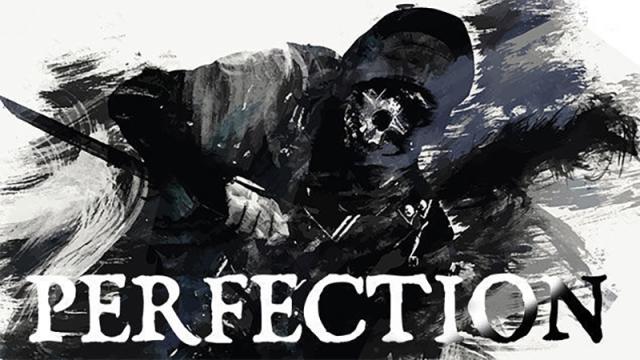
Comments
20 responses to “Dishonored’s Party Level Rewrote The Rules Of Stealth Games”
The developers admitted that Lady Boyle managed to get away from the stalker.
What I’m annoyed about stealth games are when your actions are ignored. I’m pretty sure guards would notice if some of them were missing. What I liked about MGS is that they added in checkups for guards. If they don’t get a response they send a squad to investigate. Problem is, if they don’t find anyone, they leave and nothing happens.
They could program in guards checking up on each other and becoming cautious the more that are missing. Like a reverse Batman game where the criminals become more paranoid as they’re picked off. Leaving one jumpy guy who has a special reaction if you can manage to stand behind him as he turns around.
I love Dishonored, but if it rejected a ‘right’ way to play, the endings would probably be different (broadly speaking). Sure it lets you play however you want, but it seems to be passively discouraging one way. But speaking as someone who played unseen, no powers, & no kills – I enjoyed this level forcing you out of that playstyle.
Didn’t Oblivion do something similar in a Dark Brotherhood mission? Except that you had to kill everyone but couldn’t be seen killing anyone.
Yeah, fun times.
Great game. Great read.
I’m reminded quite a bit of the Kasumi heist mission in Mass Effect 2, rather brazenly infiltrate a high society party and conduct an undercover mission without anyone being the wiser. At least for a while, admittedly it all went a trifle loud in an unavoidable manner partway through but prior to that, it was all social and stealth
Great article, guys! Keep this kind of thing up 🙂
I think the author is partially incorrect. There’s a Chaos measurement that affects the story endings in the game. There is a subtle push by the developers to steer players to a ‘good’ ending (one with less rats and a saved city, basically).
Full disclosure, I play as non-lethally as possible in games that offer it as intentional mechanic.
Oh – and I really enjoyed Dishonored.
Good read about a good game. Good.
Tried to read, but those gifs make me feel like I’m falling down a shaft…
If there’s going to be moving images on an article, (the majority of the time) choose video not gif. That way readers can play/pause if they choose.
While I agree, a lot of these things were done in Arkham Asylum first, for me IMHO anyway. For example: The fireworks etc. I know it’s not like-for-like, but for me Arkham was the game that came closest to innovating/ bringing Stealth gameplay to the mainstream market.
On a side note, I think the stealthiness of the first Arkham is why it’s still the best.
Hrmm, Arkham is a different sort of game to Dishonored though- the stealth was really only a big factor in the Predator rooms, much more set-piece oriented.
Arkham definitely never tried social stealth.
Oh, I know, as I said it’s not ‘like-for-like’, but I do feel Arkham paved the way for Dishonoured in some ways (Just like Sly on PS2 paved the way for Arkham and Assassins Creed in SOME ways). The stealth in Dishonoured always reminded me, personally of the Predator rooms. But as you say, they are still different.
On another side note, I miss that in Asylum I had to sneak around everywhere until the area was cleared of enemies, even in the courtyards. I really felt vulnerable compared to City where you just… sorta, swooped in and kicked ass.
Hmm, I would argue that Dishonored didn’t really rewrite these “rules”, rather it was the first game to pull them together coherently and not in a way that felt too contrived. One of my favourite things about the Tenchu series was the freedom you had in how to get to your target (except for those stupid cave levels…) and the tools you could use and how you could use them. The Assassin’s Creed games were already doing social stealth before Dishonored too but it was less natural and more like picking up a “stealth” powerup.
The party mission was the most enjoyable mission in the game because it was not the standard stealth of the rest of the game, but I actually found the fact that everyone just accepted you had “dark taste” required a large suspension of disbelief. To me, the duel also felt forced and was one of the rare moments when you had no freedom and had to do what the game wanted.
I still remember when the first Assassin’s Creed video was shown years ago. A mate of mine rang me and said “Hey man there’s this stealth assassinating game, but you actually want -as many- witnesses as possible to your killings”. The idea of this complete opposite kind of assassin game was really exciting. I enjoyed the AC games still, it’s just a shame the series has sort of lost its way from the assassination genre.
I found that Dishonored did encourage people to play more stealth like and non-lethal. The more you killed the higher the chaos rating increased, and it determined how a character reacted in the final mission (not to mention the endings).
My biggest problem with Dishonored (and I loved the game) was that it gave you may inventive ways to kill people and then punished you with the bad ending for killing people.
It’s a shame Splinter Cell: BL perfectionist was piss easy.
My favourite way to kill the girl at the party was to freeze time, stab them and cause their body to disappear and then be on my merry way with someone erased from existence.
Only got through half the article (and it seemed to be a good article) before I stopped cause of those farking gifs just pissed me off so much! Far too hard to read between annoying flashes of animations, it’s annoying enough to have shifting images constantly on the side and it’s the same gripe I have with annoying adverts that continually have moving animations, it makes it far too difficult for already sore or tired eyes to read! Either stop it, have a lot less, or choose ones without as much animation. Please!